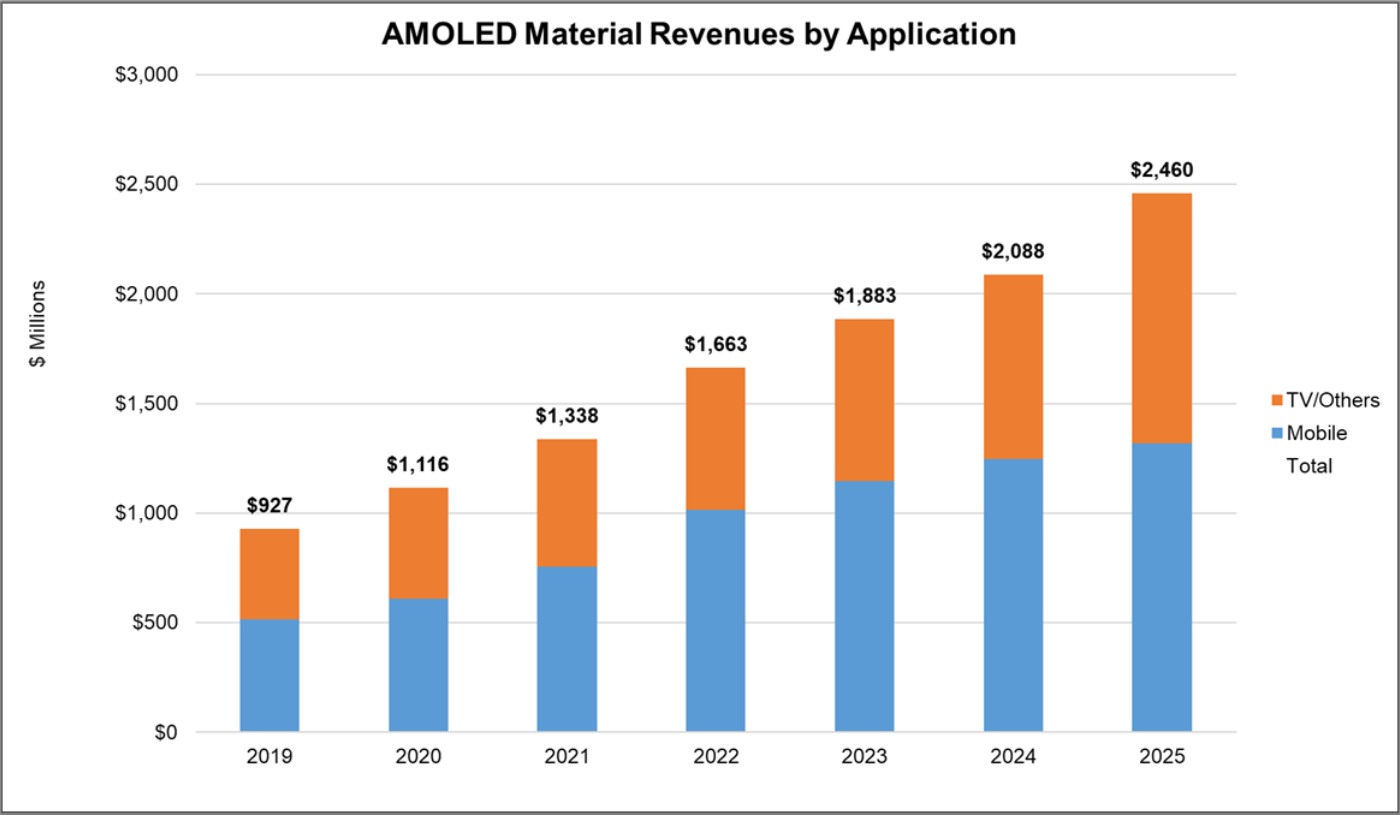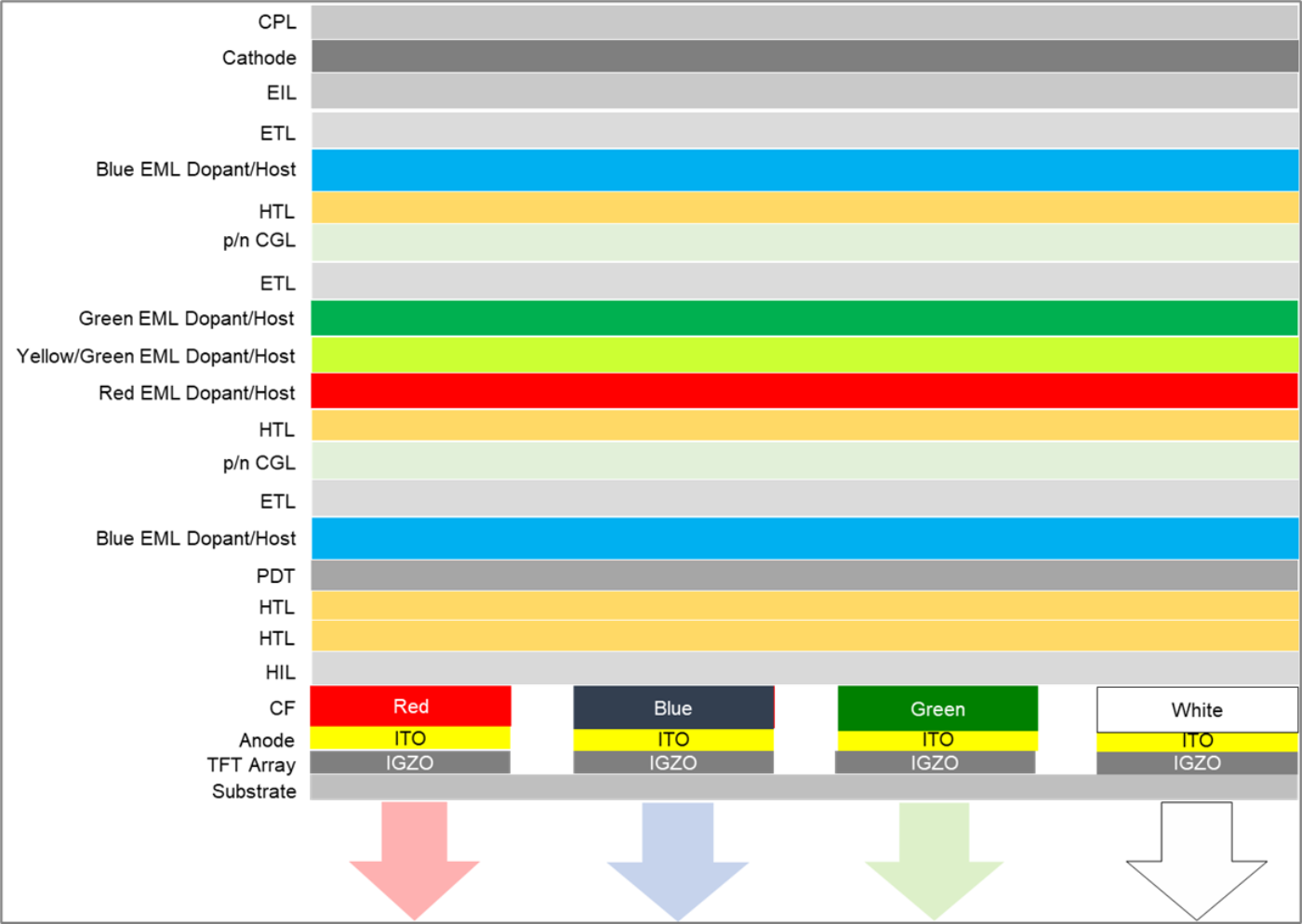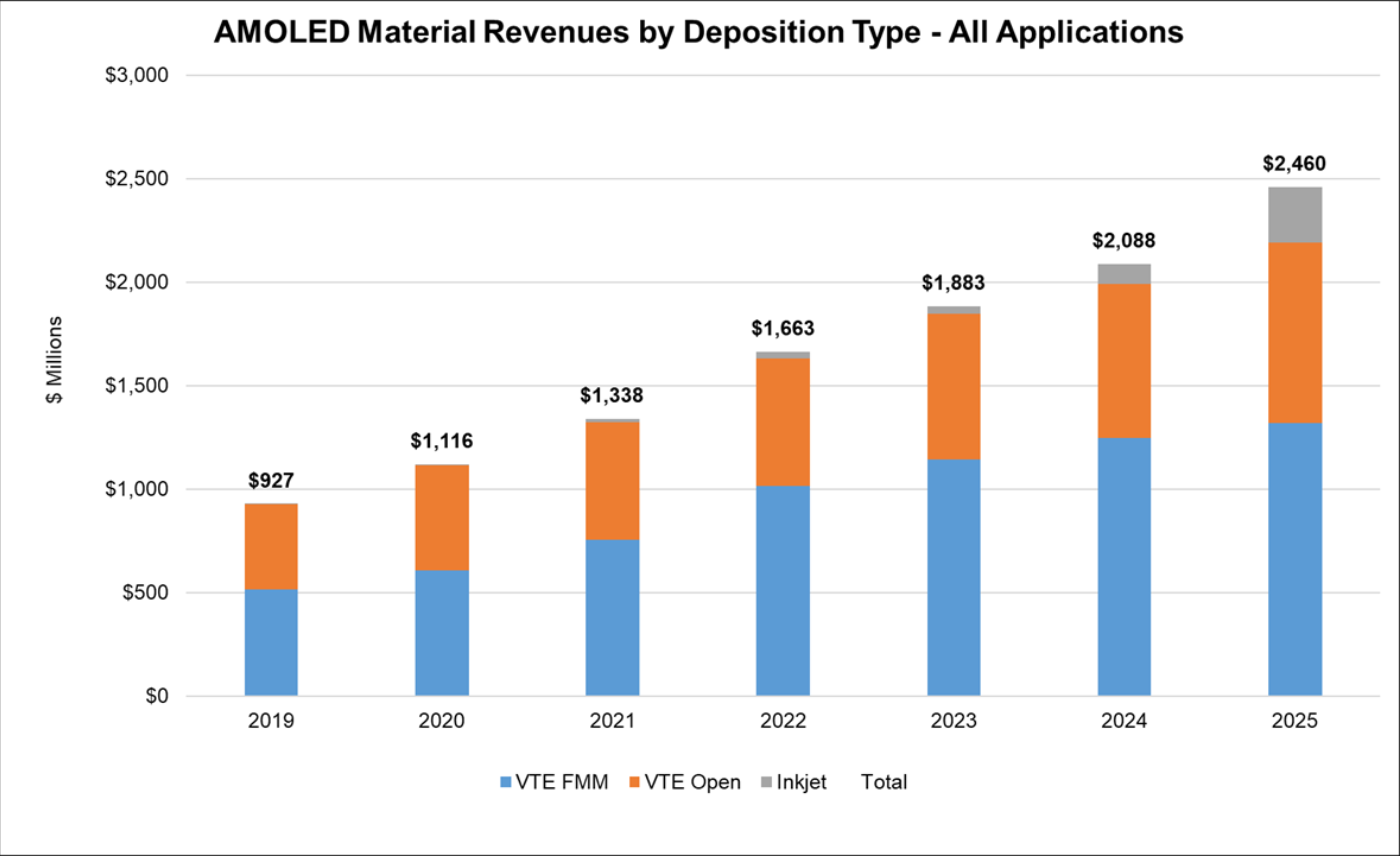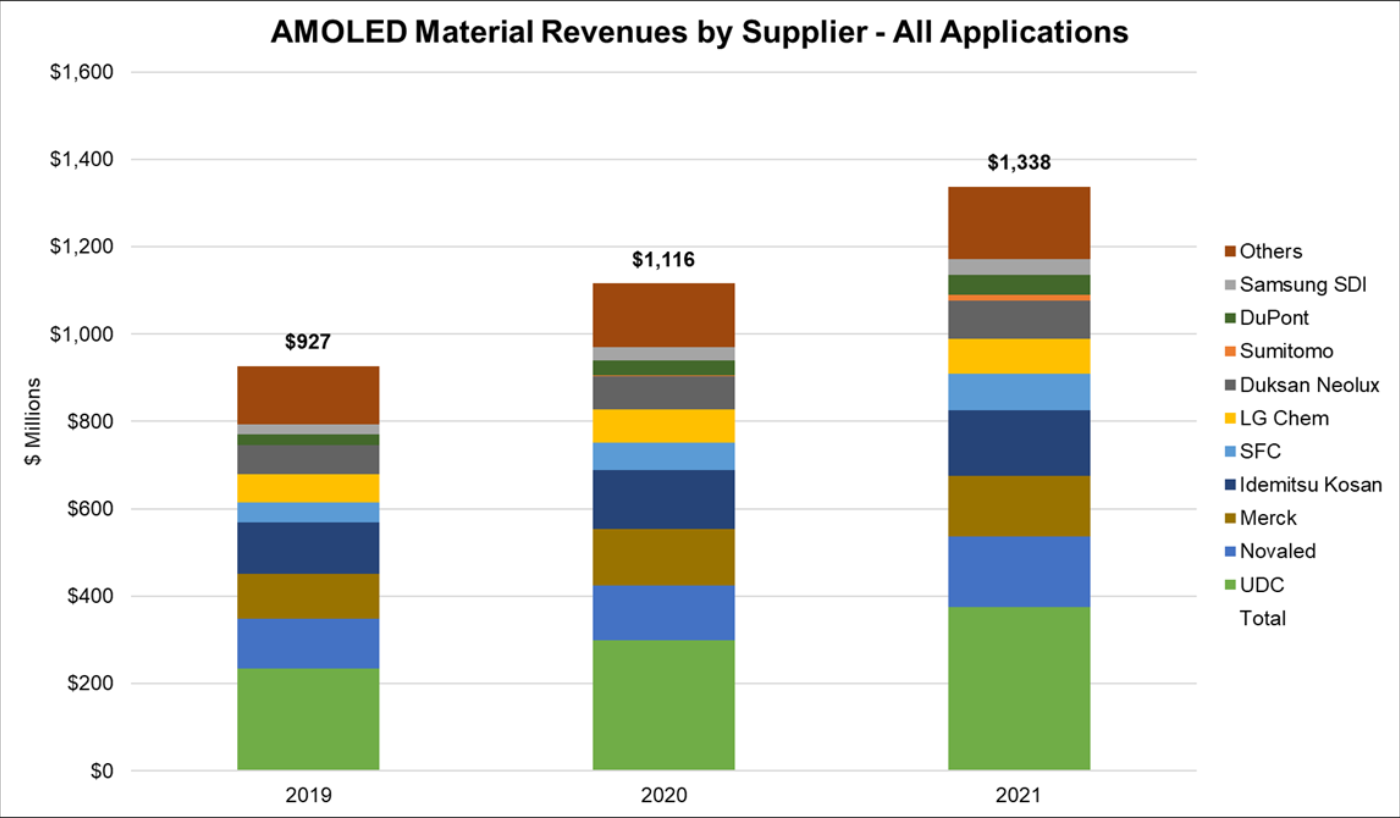国内お問い合わせ窓口
info@displaysupplychain.co.jp
FOR IMMEDIATE RELEASE: 02/04/2021
[Blog] AMOLED Materials Market Will Grow to $2.5 Billion by 2025
Bob O'Brien, Co-Founder, Principal AnalystAnn Arbor, MI USA -
Sales for AMOLED stack materials for all applications are expected to grow at a 18% annual rate from $927 million in 2019 to $2.46 billion in 2024, according to the latest update of DSCC’s Quarterly AMOLED Material Report. The report details all aspects of AMOLED materials, including multiple applications, supplier matrices and cost comparisons.
This quarter’s report incorporates the latest update to DSCC’s capacity and utilization outlook for AMOLED, and we expect that the growth of AMOLED in TV and phones, as well as other applications, will continue to drive material sales. This quarter’s outlook on material sales growth is increased from last quarter, as we now expect higher AMOLED input area for rigid panels based on increasing use of rigid AMOLED panels in IT devices (notebooks and tablets). We also now have a revised view of OLED TV increases.
For this quarter, we also include analysis of LG Display’s new OLED Evo panels. LGD has added a green emitting layer to the OLED stack to improve brightness by 20%; this new emitting layer adds cost and our report provides a first estimate of the cost adder.
Our forecast for AMOLED material revenues by application is shown in the first chart here. We expect that revenues from small and medium panels in mobile applications will continue to generate more than 50% of all AMOLED material revenues through 2025, mainly because new capacity for OLED TV such as QD OLED and Inkjet Printed OLED will have lower material revenue per panel. While OLED Evo goes in the other direction by adding cost to the OLED stack, we expect that OLED Evo will represent only a small fraction of LGD’s output, rising to 10% in 2025, so the added revenue contribution from OLED Evo will be modest.
We expect materials revenue from Mobile applications to increase at a 17% CAGR to $1.32 billion, while revenue from AMOLED TV and other large-screen applications will increase at a 19% CAGR to $1.14 billion.
AMOLED Material Revenues by Application, 2019-2025
The report details the OLED stack configurations of all the major AMOLED product architectures, including Small/Medium panels with RGB pixel structure, White OLED (WOLED) by LGD for TV panels, QD-OLED by Samsung and now OLED Evo by LGD. The stack diagram for OLED Evo is shown below. The stack profiles, along with estimates of material thickness, material utilization and material prices, form a picture of the unyielded stack cost for each AMOLED product architecture.
We expect that steady, incremental improvements in material utilization and price will help LGD drive the unyielded stack cost of its standard WOLED panels from $88.14 per square meter in 2019 to $49.83 per square meter in 2025. With the additional emitting layer, we estimate that the unyielded stack cost of the OLED Evo panel adds almost $20 per square meter in cost, and although this figure also declines over time we estimate the cost adder in 2025 remains more than $16 per square meter. With this continuing cost adder, we expect that OLED Evo will continue to be positioned as a premium product, and that the additional green layer will not be used on LGD’s mainstream products.
OLED Stack Diagram for LG Display’s OLED Evo Product
Our report provides an estimate of AMOLED stack material costs for IJP panels, which are expected to be as much as 50% lower than unyielded WOLED stack costs in 2025. Similarly, we expect that the OLED stack costs for QD-OLED will be substantially lower than those for WOLED. When QD-OLED is introduced starting in 2021, its unyielded stack costs are expected to be 30-40% lower than the standard WOLED. Of course, for both QD-OLED and IJP OLED the unyielded stack cost is only a part of the picture, because the yields on the mature WOLED technology will certainly be higher than those for QD-OLED and IJP OLED in their initial stages, and the color converter in QD-OLED will be substantially more expensive than the color filter used in WOLED. While we expect the OLED stack cost of QD-OLED to be lower than that of WOLED, we expect the total product cost of QD-OLED to be higher.
With CSOT’s planned investment in a Gen 8.5 AMOLED fab using inkjet printing with production starting in 2024, the revenues for soluble materials for inkjet-printed OLED will grow rapidly in 2024-2025. Nevertheless, the AMOLED materials market, in terms of overall revenues, will continue to be dominated by evaporated materials. Evaporated materials will remain the only type used for smaller AMOLED panels for smartphones and will continue to dominate the market for OLED TV panels. We expect that revenues from soluble materials for inkjet-printed OLED will grow from less than $1 million in 2019 to $268 million in 2025, when they will represent 23% of the TV/Other segment but still only 11% of the overall AMOLED materials market.
Material Revenues by Deposition Type, 2019-2025
Based on the existing supplier matrix, the report includes a projection of AMOLED material revenues by supplier, as shown on the next chart. Universal Display Corporation (UDC) has been the #1 supplier in revenues for the industry, and we expect that to continue. Idemitsu Kosan, Novaled and Merck hold the number two through four positions among materials suppliers. These four companies are expected to capture 62% of industry revenues in 2021, but as the chart indicates there is a long tail of companies supplying materials into the industry.
AMOLED Materials Revenues by Supplier, 2019 – 2021
The DSCC Quarterly AMOLED Material Report includes profiles for all major AMOLED stack architectures, supplier matrices for the main OLED panel makers and revenue projections for 18 different material types and 20 material suppliers. For more information about the report, please contact info@displaysupplychain.co.jp in Japan.
About Counterpoint
https://www.displaysupplychain.co.jp/about
[一般のお客様:本記事の出典調査レポートのお引き合い]
上記「国内お問い合わせ窓口」にて承ります。会社名・部署名・お名前、および対象レポート名またはブログタイトルをお書き添えの上、メール送信をお願い申し上げます。和文概要資料、商品サンプル、国内販売価格を返信させていただきます。
[報道関係者様:本記事の日本語解説&データ入手のご要望]
上記「国内お問い合わせ窓口」にて承ります。媒体名・お名前・ご要望内容、および必要回答日時をお書き添えの上、メール送信をお願い申し上げます。記者様の締切時刻までに、国内アナリストが最大限・迅速にサポートさせていただきます。



